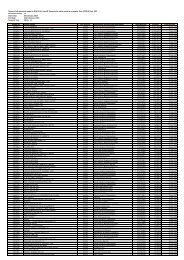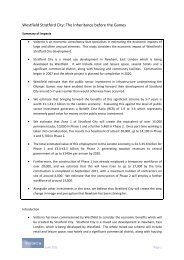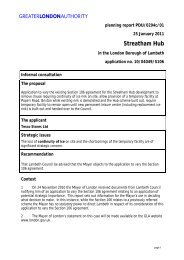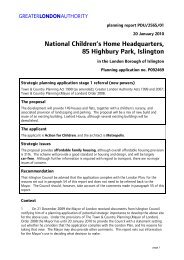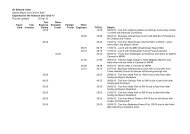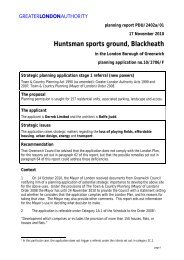Vauxhall Nine Elms Battersea Opportunity Area Planning Framework
Vauxhall Nine Elms Battersea Opportunity Area Planning Framework
Vauxhall Nine Elms Battersea Opportunity Area Planning Framework
Create successful ePaper yourself
Turn your PDF publications into a flip-book with our unique Google optimized e-Paper software.
<strong>Vauxhall</strong> <strong>Nine</strong> <strong>Elms</strong> <strong>Battersea</strong> <strong>Opportunity</strong> <strong>Area</strong> <strong>Planning</strong> <strong>Framework</strong>TA 02 Built and heritage contextMayor of London 183This map is based upon Ordnance Survey material with the permissionof Ordnance Survey on behalf of the Controller of Her Majesty’sStationery Office © Crown Copyright. Unauthorised reproductioninfringes Crown Copyright and may lead to prosecution or criminalproceedings. English Heritage 100019088. 2008Market gardeningMarket gardening began in <strong>Battersea</strong> in thelate 16th or early 17th century. By the end ofthe 18th century, much of eastern <strong>Battersea</strong>was taken up with market gardens supplyingthe London market. There were about 300acres of market gardens in <strong>Battersea</strong> parishin the 1790s, and 250 acres in Lambethparish. Property deeds indicate that someof the land in the northern part of the studyarea, around Fore Street and Ferry Street inLambeth was open ground up to the 18thcenturies. Much of the remaining open landin <strong>Vauxhall</strong> and Lambeth in 1800 was stillused for market gardening.<strong>Vauxhall</strong> Gardens andother places of entertainmentSpring Gardens (later called <strong>Vauxhall</strong>Gardens) was established in about 1660,around the time of the restoration of theMonarchy. They were one of the mainplaces of entertainment for Londoners forthe following two centuries. The Gardenssuffered a series of financial difficulties inthe 1840s and finally closed in 1859.The Gardens lay between Goding Street tothe west, <strong>Vauxhall</strong> Walk and Leopold Walkon the north, St Oswald’s Place on the eastand Kennington Lane on the south. A fewyears after its sale by auction in 1859, thewhole site was built over. The manager’sresidence on Kennington Lane later becamethe vicarage of St Peter’s church.There were other places of entertainment.The Red House Tavern was established onthe river embankment between the sites ofChelsea and Grosvenor Bridges by 1772.Nearby in eastern <strong>Battersea</strong> in the late 18thand 19th centuries were the Regency TeaGardens, the Flora Tea Gardens and the TivoliGardens. Cumberland Tavern and Tea Gardenslay on the riverfront south of the site of<strong>Vauxhall</strong> Bridge. The tavern burnt downin 1825.Figure TA2.7 Stanford 1862(Source: English Heritage HAA report)




